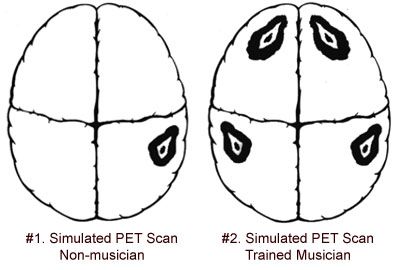Brain PET Scans and Music
©Arlene R. Taylor PhD
PET Scan studies have shown the positive benefits to the brain that can accrue through the study of music. In one such study, an individual without any special musical training had his neuronal activity recorded while he listened to a selection of symphonic music. Increased activity was shown in the right temporal lobe (see #1).
Then the procedure was repeated with a trained musician. There was increased activity in the right temporal lobe (involved in the processing of nonspeech sounds), but increased activity was noted throughout the cerebrum, as well (see #2).

Increased activity showed in the left temporal lobe, involved with processing the form of music (e.g., chord structure, recognizing signs that represent sounds, time signatures, measures). The left frontal lobe showed increased activity in which the musical experience was being analyzed. And there was increased activity in the right frontal lobe as the musician mentally pictured instruments he identified by their sound.
More than 300 years ago Francois Couperin, the French composer, declared that by the age of six or seven children should begin studying instruments. No wonder! Taking music lessons may be one of the best strategies for building competencies throughout the cerebrum. In the process, you may age-proof your brain, as well!

